扩展功能
文章信息
- 高奕, 毛一萍, 王晓林, 陈熠楠, 张新卫, 龚震宇
- GAO Yi, MAO Yi-ping, WANG Xiao-lin, CHEN Yi-nan, ZHANG Xin-wei, GONG Zhen-yu
- 浙江省首届病媒生物防制职业技能竞赛疾控机构成绩及队伍建设需求分析
- Results of disease control institutions in the first Zhejiang vocational skill competition for vector control and demand for team building
- 中国媒介生物学及控制杂志, 2023, 34(3): 400-405
- Chin J Vector Biol & Control, 2023, 34(3): 400-405
- 10.11853/j.issn.1003.8280.2023.03.020
-
文章历史
- 收稿日期: 2022-12-10
2 浙江省除四害科技协会, 浙江 杭州 310002;
3 浙江省疾病预防控制中心传染病防制所, 浙江 杭州 310051
2 Zhejiang Province Pest Control Scientific Association, Hangzhou, Zhejiang 310002, China;
3 Department of Infectious Control and Prevention, Zhejiang Provincial Center for Disease Control and Prevention, Hangzhou, Zhejiang 310051, China
病媒生物防制是疾病预防控制的重要任务之一。近年来,随着登革热、寨卡病毒病、新型冠状病毒肺炎等传染病疫情在浙江省发生流行,尤其亚运会等重大活动举办带来的保障需求增加,病媒生物防制受到更多的关注,同时专业队伍数量、能力不足问题凸显[1-3]。一直以来浙江省疾病预防控制(疾控)机构没有系统的病媒生物防制专项考核评估,更多通过业务培训、继续教育项目以及业务条线工作督查等反映。为推进浙江省病媒生物防制队伍建设,提升各级疾控机构能力,浙江省爱国卫生运动委员会办公室(爱卫办)、浙江省卫生健康委、浙江省总工会联合举办了2019年浙江省首届病媒生物防制职业技能竞赛。本文对竞赛的参赛选手成绩进行分析,了解防制专业人员知识水平和存在问题,为今后队伍防制能力建设、培训改革提供参考依据。
1 材料与方法 1.1 研究对象选取2019年浙江省首届病媒生物防制职业技能竞赛决赛12支队伍36名参赛队员为研究对象。
1.2 方法 1.2.1 竞赛队伍组成浙江省11个设区市和省疾控中心共12支代表队,每支队伍5人,包括1名领队、1名联络员和3名参赛选手。参赛选手为市级初赛优胜者,年龄原则上≤50岁,每支队伍至少有1名≤35岁选手,经省级资格审查合格产生。
1.2.2 竞赛赛制设置浙江省爱卫办、浙江省卫生健康委、浙江省总工会联合成立竞赛活动组委会,负责竞赛活动的组织策划,下设3个工作组。竞赛赛制分理论测试和技能操作2个环节5个科目,其中理论测试环节分理论考试和知识竞答2个科目,技能操作环节分标本鉴定、监测技术和器械操作3个科目。理论考试采用参赛选手抽签编号,其他4个科目按参赛队伍抽签顺序确定排列顺序号和3名队员场次座位号,每支队伍、每位选手在各科目规定时限完成竞赛内容。
1.2.3 竞赛内容成立病媒生物专家组,负责竞赛科目命题。5个竞赛科目总分490分,其中理论考试、标本鉴定、监测技术、器械操作科目均为100分,知识竞答科目90分。理论考试科目注重常见病媒生物防制基础理论与实践技能知识的考察;知识竞答科目设置必答题、抢答题和风险题3种题型,考察参赛队伍知识判断、现场技术运用和综合分析能力,不同题型回答错误均按不得分处理;标本鉴定要求选手独立完成蚊、蝇、蜚蠊、蜱等标本种类的形态学鉴定;监测技术考察选手鼠、蝇等现场监测器械使用、布放位置及注意事项等;器械操作模拟现场疫点处置情景,考察参赛队伍现场病媒生物控制操作规范程度。
1.2.4 考核评分理论测试集中在考场进行,选手根据抽签顺序入座,答题时间90 min。知识竞答各队组队参赛,主持人主持,按照每题时间要求播放PPT和宣读题目,选手独立书面答题,答题时间90 min。技能操作3个科目分别设置3个模拟现场,其中标本鉴定和监测技术由选手独立完成,器械操作由队伍3名选手互相配合完成。病媒生物专家组成3个评分组,每组由2名专家,按照标准答案评分,总答题时间45 min。
1.2.5 成绩计算个人赛和团体赛成绩均包括理论及技能操作2个部分。个人赛成绩:理论考试成绩按权重30%计入总分;标本鉴定和现场监测的平均分按权重70%计入总分。团体赛成绩:3名队员理论考试的平均分按权重20%计入总分,知识竞答得分按权重10%计入总分;3名队员标本鉴定和现场监测的平均分各按权重20%计入总分,器械操作得分按权重30%计入总分。评出团体和个人一、二、三等奖,获得一、二等奖的个人选手按相关规定向省总工会申报“浙江金蓝领”。
1.3 统计学分析对竞赛数据用Shapiro-Wilk检验进行正态性检验,使用SPSS 25.0软件对参赛选手竞赛数据进行统计分析,对于正态分布数据,多组间的均数比较采用方差分析方法处理,组内多重比较采用Bonferroni(邦弗伦尼)法;对于偏态分布数据,多组间的均数比较采用Kruskal-Wallis秩和检验,组间两两比较采用Kruskal-Wallis单因素ANOVA(k个样本)检验。P < 0.05为差异有统计学意义。
2 结果 2.1 基本情况参赛12支队伍36名队员中,男性26人,女性10人;初级、中级、副高及以上职称的分别占25.0%、61.1%和13.9%;工作年限 < 5、5~10、> 10年的分别占27.8%、33.3%和38.9%;省级疾控中心3人,市级疾控中心20人,县级疾控中心13人。
2.2 参赛队伍不同环节科目得分12支队伍团体成绩最高得分428.83分,按100分标化换算,标化得分88.77分,最低得分333.67分,标化得分68.13分,平均得分359.07分,标化得分75.01分。按标化得分60.00分为及格线,及格率为100%。见图 1。

|
| 图 1 浙江省首届病媒生物防制职业技能竞赛各参赛队伍总体得分情况 Figure 1 Overall scores of the 12 teams in the first Zhejiang vocational skill competition for vector control |
| |
12支队伍不同科目得分差异有统计学意义(F=55.787,P < 0.001),其中理论考试科目与其他4个科目、知识竞答科目与其他4个科目得分差异均有统计学意义(均P < 0.05),标本鉴定、现场监测、器械操作3个科目两两之间得分差异均无统计学意义(均P > 0.05)。从最高分和最低分看,现场监测科目差距最小,各队该项目技术水平相对较为接近;知识竞答得分差距较大。见图 2。
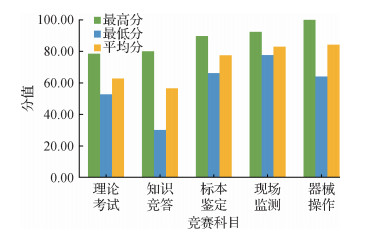
|
| 图 2 浙江省首届病媒生物防制职业技能竞赛不同科目得分情况 Figure 2 Scores in different subjects in the first Zhejiang vocational skill competition for vector control |
| |
36名参赛选手个人成绩按100分标化换算,最高得分88.90分,最低得分60.70分,平均得分74.99分,其中得分 > 80分的选手7名。对参赛选手按工作年限、技术职称、所属层级、机构设置、工作性质(专兼职)、人员配备等分析,来自机构设置、人员配备不同的机构和工作性质不同的选手个人得分差异有统计学意义(F=11.897,P=0.002;F=14.737,P=0.001;F=10.627,P=0.003)。见表 1。
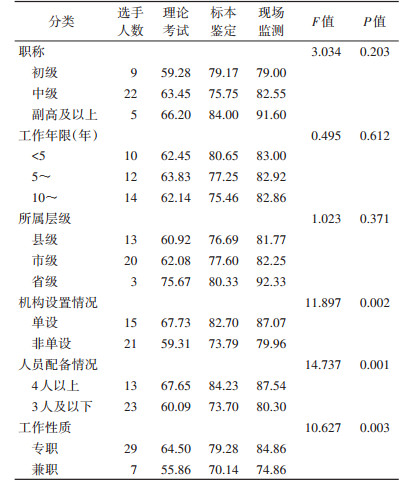
|
对理论考试单选题20题、多选题10题、填空题10题、简答题2题和论述题1题,按5种知识类别进行比较,选手不同知识技能得分差异有统计学意义(F=28.732,P < 0.001)(表 2)。5种知识类别中,药械使用、综合分析与其他3种知识类别得分差异均有统计学意义(均P < 0.05),防制应用、监测技术、基础知识3种知识类别得分差异无统计学意义(均P > 0.05)。

|
12支队伍知识竞答必答题6题、抢答题12题和风险题12题得分,按5种知识类别进行正态性检验,数据呈偏态分布。采用Kruskal-Wallis检验显示,5组题型的标化得分差异有统计学意义(H=26.131,P < 0.001)(表 3)。经两两比较,虫种鉴定与监测评价和处置技术,药械使用与监测评价和处置技术,基础知识与监测评价和处置技术差异均有统计学意义(均P < 0.05)。
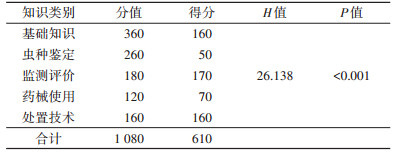
|
对虫种鉴定5个考核要点得分进行正态性检验,数据呈偏态分布。采用Kruskal-Wallis检验显示,5组题型的标化得分差异有统计学意义(H=43.613,P < 0.001)。经过两两比较,蚊特征描述、蜚蠊或蝇特征描述分别与其他3个考核要点得分差异有统计学意义(均P < 0.05)。见表 4。

|
对36名参赛选手50 m2室内现场用夹夜法监测鼠类8个考核要点进行分析,数据呈偏态分布。采用Kruskal-Wallis检验显示,8个考核要点的标化得分差异有统计学意义(H=73.847,P < 0.001)(表 5)。经过两两比较,记录与其他7个考核要点、回收与诱饵选择差异均有统计学意义(均P < 0.05)。见表 5。
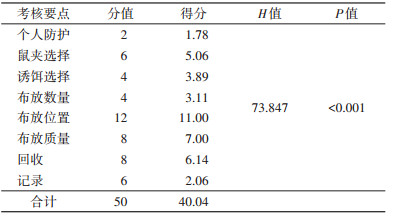
|
对36名选手模拟农贸市场环境用笼诱法监测蝇类5个考核要点进行分析,数据呈偏态分布。采用Kruskal-Wallis检验显示,5个考核要点的标化得分差异有统计学意义(H=115.744,P < 0.001)(表 6)。经过两两比较,记录与其他4个考核要点得分差异均有统计学意义(均P < 0.05)。其他4个考核要点得分差异无统计学意义(均P > 0.05)。
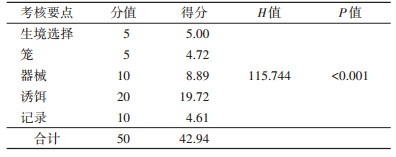
|
对12支队伍现场模拟某小区室内环境滞留喷洒操作的考核要点得分进行对比,数据呈偏态分布,采用Kruskal-Wallis检验显示,6个考核要点的标化得分差异有统计学意义(H=24.262,P < 0.001)(表 7)。经过两两比较,药液配置与个人防护和事后处理,实际操作与事后处理得分的差异有统计学意义(均P < 0.05)。

|
以赛促练。近年来,随着登革热防控、救灾防病、重大活动尤其是亚运会保障等需要,疾控机构病媒生物防制队伍能力的重要性越发凸显[4-6]。技能竞赛是引导提高专业技术水平的有效途径,本次竞赛科目设置合理,考题贴近实际,知识覆盖面广,展现了浙江省病媒生物防制工作者良好的专业技能,衡量了选手真实水平并找到了短板和不足,营造了崇尚技能、学习技能的浓厚氛围,为后续促进人才培养内涵式发展,推动队伍建设起到积极作用[7-8],本次获奖选手分别被授予“浙江金蓝领”“省级技能标兵”“省级技术能手”称号。
以赛促教。本次竞赛成绩体现了浙江省专业机构最高水准,与2016年浙江省除四害科技协会组织的全省有害生物防治业(PCO)队伍技能竞赛成绩相比,队伍平均得分率提高了20个百分点[9]。竞赛发现,不同队伍、不同选手、不同科目得分不平衡,选手普遍在综合分析、监测评价、专业指导等知识要点上得分较高,但是理论基础掌握不足,尤其是虫种鉴定、药物配制、器械使用等与现场操作关系密切的知识点掌握存在薄弱环节,实战锻炼不足,表明浙江省目前培训知识巩固度和内容全面性难以满足实际需要,迫切需要建立一套涵盖整个病媒生物防制实际,以职业技能为核心、以防制任务为依据的综合课程体系,将培养目标融入教学课程,强化实践技能训练,突出应用型和实用型,体现“全科技能”培养特色[10]。
以赛促建。适宜的人力资源配置是有效落实各项疾病预防控制工作的必要条件,人员不足已成为病媒生物监测防制无法有效开展的重要原因之一[11-12]。本次竞赛看出,疾控机构病媒岗位独立设置、专职人员配备差异带来的能力差异显著,建议在疫情常态化防控背景下,按照国家疾病预防控制岗位设置管理指导意见要求,合理配置人力资源,探索区域防制特色,推进学科建设,建立分类量化评价机制,构建部门职责清晰、学科体系健全、岗位分布科学、绩效考核和职业生涯规划完善的岗位设置管理体系,使岗位设置和管理能够以服务疾控科研能力建设、有利于职工成长为出发点和落脚点,提升核心竞争力[13-15]。
以赛促融。技能竞赛既是展现技术水平的一个窗口,也是专业机构与行政部门、院校企业之间交流合作的一个平台。在机制建设上,推动技能竞赛常态化建设,将其纳入疾控机构建设标准要求,增设更加科学、可区分度高的科目,作为评价疾控机构能力重要依据之一。在方式方法上,完善疾控机构每年常规业务培训和继续教育,把技能竞赛与岗位技能要求、课程设置改进、实践教学需求、项目建设等结合起来,形成专业建设与技能竞赛相结合人才培养机制[16-17]。在平台载体上,借助企业和院校资源,建立技能竞赛基地、实训教学阵地,开展病媒生物仪器设备和适宜技术研发等校企合作,拓展实训基地功能,加大产学研用融合,真正让技能竞赛从小课堂走向社会大课堂。
利益冲突 无
| [1] |
张新卫, 高奕. 公共环境病媒生物防制指南[M]. 杭州: 浙江科学技术出版社, 2021: 2. Zhang XW, Gao Y. Guidelines for vector control in the public environment[M]. Hangzhou: Zhejiang Science and Technology Publishing House, 2021: 2. |
| [2] |
刘起勇, 刘小波, 常楠, 等. 2012-2021我国媒介生物及相关传染病监测控制进展及成效[J]. 中国媒介生物学及控制杂志, 2022, 33(5): 613-621. Liu QY, Liu XB, Chang N, et al. Advances and achievements in the surveillance and control of vectors and vector-borne diseases in China, 2012-2021[J]. Chin J Vector Biol Control, 2022, 33(5): 613-621. DOI:10.11853/j.issn.1003.8280.2022.05.001 |
| [3] |
龚震宇, 张新卫, 侯娟, 等. 浙江省病媒生物防制工作实践、存在的问题及对策建议[J]. 中国媒介生物学及控制杂志, 2020, 31(2): 121-125. Gong ZY, Zhang XW, Hou J, et al. Practice, deficiencies, and countermeasures of vector control in Zhejiang province, China[J]. Chin J Vector Biol Control, 2020, 31(2): 121-125. DOI:10.11853/j.issn.1003.8280.2020.02.001 |
| [4] |
刘起勇. 新时代媒介生物传染病形势及防控对策[J]. 中国媒介生物学及控制杂志, 2019, 30(1): 1-6, 11. Liu QY. Epidemic profile of vector-borne diseases and vector control strategies in the new era[J]. Chin J Vector Biol Control, 2019, 30(1): 1-6, 11. DOI:10.11853/j.issn.1003.8280.2019.01.001 |
| [5] |
龚震宇, 刘钦梅, 王金娜, 等. 新时代中国特色爱国卫生运动增添新内涵: 病媒生物预防控制浙江模式的探索[J]. 疾病监测, 2021, 36(4): 312-317. Gong ZY, Liu QM, Wang JN, et al. New connotations for patriotic health campaign with Chinese characteristics in new era: Exploration of vector prevention and control pattern in Zhejiang[J]. Dis Surveill, 2021, 36(4): 312-317. DOI:10.3784/jbjc.202104010422 |
| [6] |
龚震宇, 刘钦梅. 新型冠状病毒肺炎疫情时代之疾病预防控制体系迎来发展新机遇[J]. 疾病监测, 2021, 36(8): 756-761. Gong, ZY, Liu QM. Discussion on the construction of disease prevention and control system in the post-COVID-19 epidemic era[J]. Dis Surveill, 2021, 36(8): 756-761. DOI:10.3784/jbjc.202107030382 |
| [7] |
孔庆鑫, 韦凌娅, 丁华, 等. 杭州市G20峰会病媒生物防制技术管理与实施机制探讨[J]. 中国媒介生物学及控制杂志, 2017, 28(5): 440-443. Kong QX, Wei LY, Ding H, et al. Management and implementation mechanism of vector control technology during Hangzhou G20 Summit[J]. Chin J Vector Biol Control, 2017, 28(5): 440-443. DOI:10.11853/j.issn.1003.8280.2017.05.007 |
| [8] |
夏蒙, 贺宏斌, 喻鑫玲, 等. 2018年湖南省血防技术人员专业技能竞赛成绩分析[J]. 热带病与寄生虫学, 2020, 18(4): 216-220. Xia M, He HB, Yu XL, et al. Analysis on the skill competition results of schistosomiasis control professionals in Hunan province in 2018[J]. J Trop Dis Parasitol, 2020, 18(4): 216-220. DOI:10.3969/j.issn.1672-2302.2020.04.006 |
| [9] |
高奕, 汪垂章, 张新卫. 浙江省病媒生物防制从业人员能力评估及培训需求分析[J]. 中国媒介生物学及控制杂志, 2022, 33(4): 471-474. Gao Y, Wang CZ, Zhang XW. Ability assessment and training demand analysis of vector control practitioners in Zhejiang province, China[J]. Chin J Vector Biol Control, 2022, 33(4): 471-474. DOI:10.11853/j.issn.1003.8280.2022.04.005 |
| [10] |
刘美德, 张勇, 钱坤, 等. 病媒生物密度监测方法国家标准在疾病预防与控制机构实施情况的研究[J]. 中国媒介生物学及控制杂志, 2017, 28(5): 416-421. Liu MD, Zhang Y, Qian K, et al. Study on the application of four vector surveillance standards in the center for disease control institutions[J]. Chin J Vector Biol Control, 2017, 28(5): 416-421. DOI:10.11853/j.issn.1003.8280.2017.05.002 |
| [11] |
郭利娜, 丁凡, 席晶晶. 全国疾病预防控制机构人力资源发展现状分析[J]. 中国公共卫生管理, 2020, 36(2): 158-161. Guo LN, Ding F, Xi JJ. Analysis on the current situation of human resources development of centers for disease control and prevention in China[J]. Chin J Public Health Manage, 2020, 36(2): 158-161. DOI:10.19568/j.cnki.23-1318.2020.02.004 |
| [12] |
鲜敏, 郑寒君, 陈加超. 深圳市各区疾控中心人力资源配置公平性研究[J]. 中国公共卫生管理, 2022, 38(4): 466-469, 474. Xian M, Zheng HJ, Chen JC. Research on the fairness of human resource allocation in district-level centers for disease control and prevention in Shenzhen city[J]. Chin J Public Health Manage, 2022, 38(4): 466-469, 474. DOI:10.19568/j.cnki.23-1318.2022.04.0009 |
| [13] |
陈艺平. 常态化疫情防控下基层疾病预防控制机构人力资源管理对策研究[J]. 中国公共卫生管理, 2022, 38(5): 610-613. Chen YP. Countermeasures of human resource management in grass-roots disease control institutions under normalized epidemic prevention and control[J]. Chin J Public Health Manage, 2022, 38(5): 610-613. DOI:10.19568/j.cnki.23-1318.2022.05.0009 |
| [14] |
董莹, 林慧波, 陶毓敏, 等. 疾控机构人力资源建设对提升科技创新能力的实践与思考[J]. 中国公共卫生管理, 2019, 35(6): 844-847. Dong Y, Lin HB, Tao YM, et al. Practice and reflection of human resource construction in CDC on the improvement of science and technology innovation ability[J]. Chin J Public Health Manage, 2019, 35(6): 844-847. DOI:10.19568/j.cnki.23-1318.2019.06.033 |
| [15] |
毛向群, 彭广萍, 董永海. 学科建设对疾病预防控制中心能力建设的作用探讨[J]. 现代预防医学, 2014, 41(22): 4091-4092. Mao XQ, Peng GP, Dong YH. Exploration of the effect of discipline construction on capacity building of center for disease control and prevention[J]. Mod Prev Med, 2014, 41(22): 4091-4092. |
| [16] |
杜真, 卢金星. 疾病预防控制中心岗位设置管理的研究与思考: 以中国疾病预防控制中心传染病预防控制所为例[J]. 中国公共卫生管理, 2021, 37(6): 740-742. Du Z, Lu JX. Research and thinking on post setting management of CDC: Through taking the infectious disease institute as an example[J]. Chin J Public Health Manage, 2021, 37(6): 740-742. DOI:10.19568/j.cnki.23-1318.2021.06.0008 |
| [17] |
张莉莉, 蔡路, 张雅明, 等. 病媒生物应急能力模拟演练模式的探讨[J]. 中国媒介生物学及控制杂志, 2016, 27(4): 416-417. Zhang LL, Cai L, Zhang YM, et al. Discussion on the drill model of the emergency vector control[J]. Chin J Vector Biol Control, 2016, 27(4): 416-417. DOI:10.11853/j.issn.1003.8280.2016.04.029 |
 2023, Vol. 34
2023, Vol. 34


